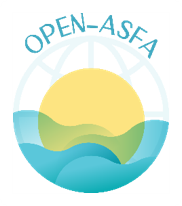Human health risk assessment of heavy metal(oid)s in four fish species harvested from the Bizerte lagoon (Tunisia)
DOI:
https://doi.org/10.71754/instm.bulletin.v49.1709Keywords:
Human health, Heavy metals, Fish, Bioaccumulation, Analysis, Contamination, Commercial species, Consumer protection, CarcinogensAbstract
This study investigated the levels of cadmium (Cd), lead (Pb), arsenic (As), iron (Fe), copper (Cu), and zinc (Zn) exposure in the child and adult populations in Tunisia. The heavy metal(loid) (HM) content in muscle and the organ mixture of four commercial species of fish widely available and consumed were determined (Sparus aurata, Dicentrarchus labrax, Liza aurata, Sarpa salpa).
The fish samples were prepared using a wet digestion method, and the HM analysis was carried out using an inductively coupled plasma mass spectrometry (ICP-MS). The results indicated that all fish organs had high amounts of Pb and As and high levels of Cd and Zn in some organs. Based on the exploratory data analysis, fish species can be differentiated according to their diet.
The estimated daily intake values for the children's population have exceeded the permissible levels for Cd and As, whereas they were only exceeded for As for the adult population. Only Fe's Target Hazard Quotient exceeded the permissible limit. The evaluation of the carcinogenic risk associated with the consumption of the four fish species from the Bizerte lagoon indicated a potential carcinogenic effect related to lead (Pb) exposure. In this lagoon, HM contamination of fish is requiring both a short-term and long-term approach to ensure the safety of marine products.
Downloads
Downloads
Published
How to Cite
Issue
Section
ARK
License
Copyright (c) 2024 Khaoula TELAHIGUE , Imen RABEH , Zied MDAINI, Ridha GHALI , Lassaad CHOUBA , Tarek HAJJI

This work is licensed under a Creative Commons Attribution 4.0 International License.












